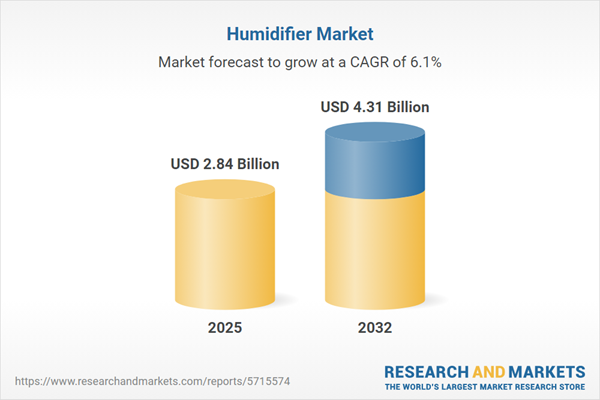Speak directly to the analyst to clarify any post sales queries you may have.
Senior decision-makers face mounting pressure to ensure a healthy, compliant indoor environment in today’s fast-evolving business landscape. The global humidifier market presents integrated technology solutions designed to address operational, regulatory, and employee well-being imperatives across diverse sectors and facility types.
Market Snapshot: Global Humidifier Market Growth and Trends
The global humidifier market is undergoing steady expansion, with projections indicating it will reach USD 4.31 billion by 2032, at a CAGR of 6.13%.
Increasing facility demands for air quality and complex regulatory requirements are prompting organizations to adopt advanced humidification systems. Modern humidifier solutions integrate seamlessly with existing building management systems, appealing to facility managers and operational leaders overseeing multi-use commercial environments. Healthcare, hospitality, and warehousing sectors now emphasize smart, data-enabled management techniques to ensure continuity and support mission-critical indoor comfort. Procurement leaders are adapting to varied regional regulations and climate-related demands, highlighting the value of technology-enabled humidifiers in building resilience and supporting flexible compliance across global operations.Scope & Segmentation of the Global Humidifier Market
- Product Types: Evaporative, impeller, steam, and ultrasonic humidifiers accommodate a range of facility requirements in both offices and industrial sites, supporting operational reliability and process-specific demands.
- Distribution Channels: Specialized retailers, major supermarkets, manufacturer e-commerce sites, and digital procurement platforms provide purchasing flexibility, supporting both enterprise-scale and site-focused strategies.
- End Users: Organizations in property management, healthcare, hospitality, warehousing, industry, and residential sectors rely on humidifiers to maintain strict air quality levels and responsive environmental controls.
- Capacity Tiers: Choices spanning large, medium, and small units allow businesses to scale solutions for different facility sizes and to integrate with both complex and simplified maintenance frameworks.
- Mist Modalities: Cool mist and warm mist options let institutions customize environmental settings, efficiently balancing energy use with occupant comfort requirements.
- Filtration Functionalities: Activated carbon, HEPA filtration, and non-filtered humidifier variants enable facility managers to target sector-specific air quality objectives and support hygienic operation.
- Global Regions Covered: The Americas, Europe, Middle East, Africa, and Asia-Pacific regions are each driving humidifier adoption, with regional regulatory demands and climate factors shaping procurement and compliance strategies.
- Key Companies Analyzed: Market research covers Koninklijke Philips N.V., Honeywell International Inc., Dyson Technology Limited, The Procter & Gamble Company, Panasonic Corporation, Sharp Corporation, Haier Group Corporation, Beurer GmbH, Vornado Air LLC, and Levoit LLC, assessing innovation, product reliability, and alignment with organizational requirements.
Key Takeaways for Senior Decision-Makers
- Connected humidification systems with advanced oversight tools integrate effortlessly into facility management workflows, improving real-time visibility and adaptive environmental responses.
- Automated filtration and high-efficiency system performance uphold hygiene standards while helping to mitigate operational risks and minimize system disruptions.
- Multiple procurement channels, including direct and digital purchasing, enable organizations to swiftly align product selection with changing operational and institutional priorities.
- Adaptive procurement processes, reinforced by resilient supply chains, support leadership teams in addressing evolving regulatory and market volatility.
- Ongoing technical support enables quick adaptation to changing facility requirements or compliance shifts, preserving product effectiveness and operational consistency.
Tariff Impact: Strategic Implications in the U.S. Market
Recent U.S. tariff adjustments have accelerated the shift toward sourcing resilience. Organizations are investing in nearshoring and local production to better safeguard operational stability and manage costs amid changing economic and regulatory pressures.
Methodology & Data Sources
This analysis combines expert interviews, hands-on assessments of top humidifier solutions, and in-depth desk research. Results were cross-referenced with regulatory reviews, procurement expert perspectives, patent insights, and direct market observations to ensure both accuracy and market relevance.
Why This Humidifier Market Report Matters
- Supports strategic planning by helping senior executives anticipate emerging technology, compliance influences, and facility integration trends.
- Enhances procurement strategies and supply chain resilience to proactively address evolving regulatory requirements.
- Equips decision-makers to adapt nimbly to shifting operational environments, improving long-term organizational agility and continuity.
Conclusion
Integrated humidifier solutions continue to support organizations seeking strong technology adoption, compliance alignment, and lasting supply chain effectiveness. Strategic, forward-looking action enables leaders to secure reliable, compliant environments across a spectrum of industries and facilities.
Additional Product Information:
- Purchase of this report includes 1 year online access with quarterly updates.
- This report can be updated on request. Please contact our Customer Experience team using the Ask a Question widget on our website.
Table of Contents
3. Executive Summary
4. Market Overview
7. Cumulative Impact of Artificial Intelligence 2025
Companies Mentioned
The companies profiled in this Humidifier market report include:- Koninklijke Philips N.V.
- Honeywell International Inc.
- Dyson Technology Limited
- The Procter & Gamble Company
- Panasonic Corporation
- Sharp Corporation
- Haier Group Corporation
- Beurer GmbH
- Vornado Air, LLC
- Levoit LLC
Table Information
| Report Attribute | Details |
|---|---|
| No. of Pages | 192 |
| Published | October 2025 |
| Forecast Period | 2025 - 2032 |
| Estimated Market Value ( USD | $ 2.84 Billion |
| Forecasted Market Value ( USD | $ 4.31 Billion |
| Compound Annual Growth Rate | 6.1% |
| Regions Covered | Global |
| No. of Companies Mentioned | 11 |









